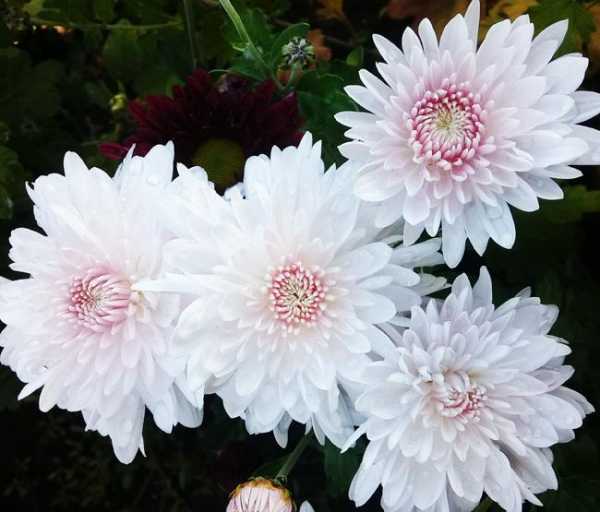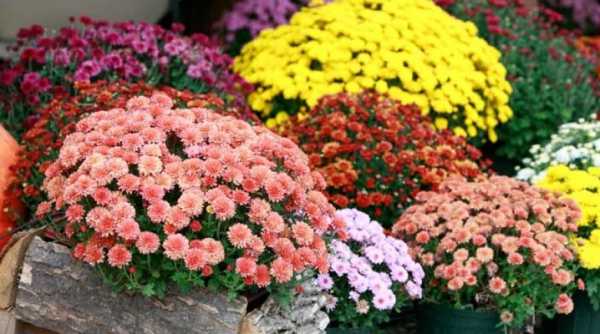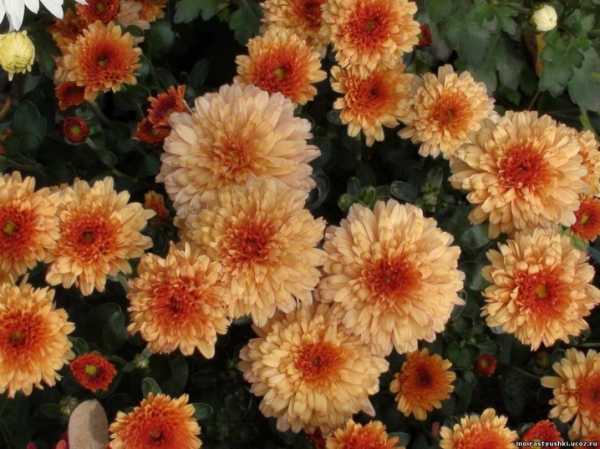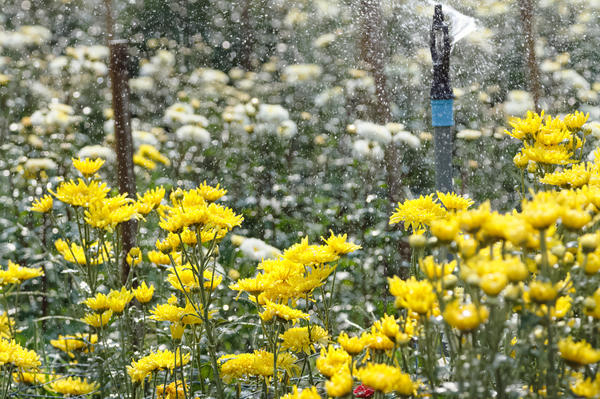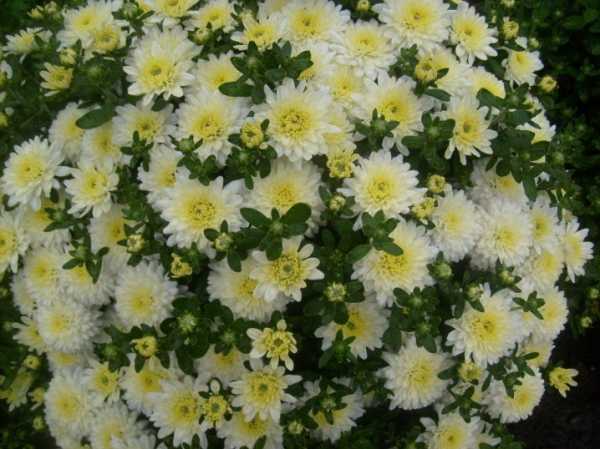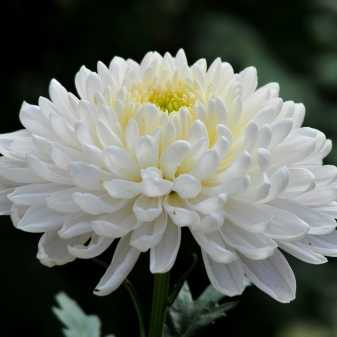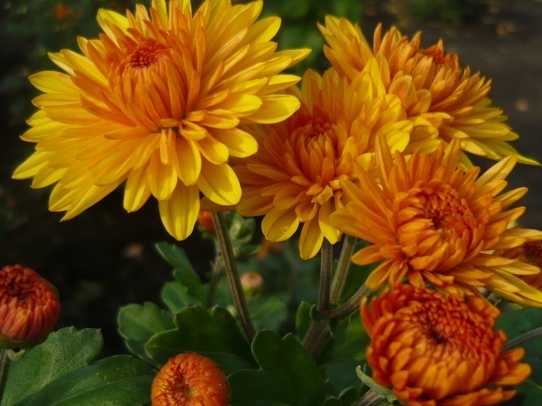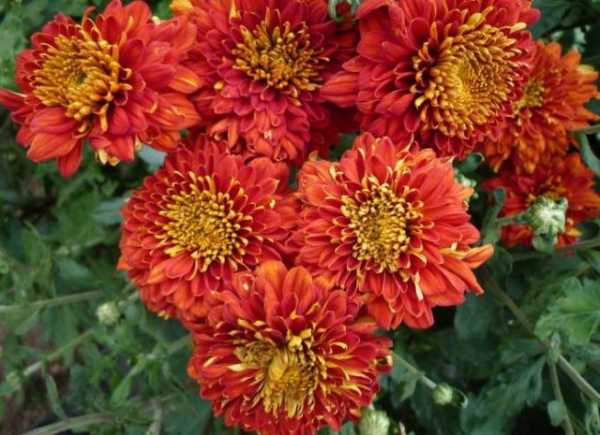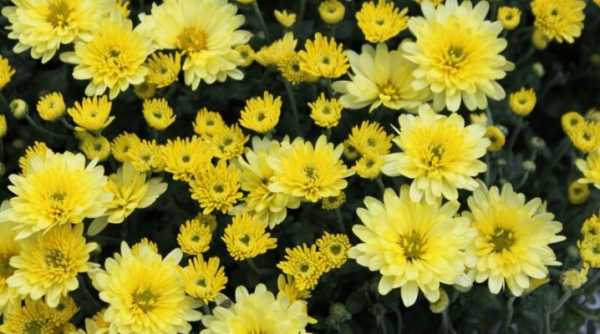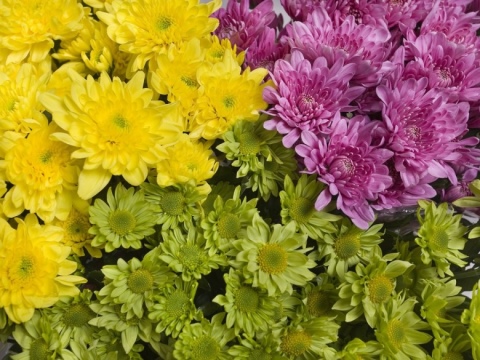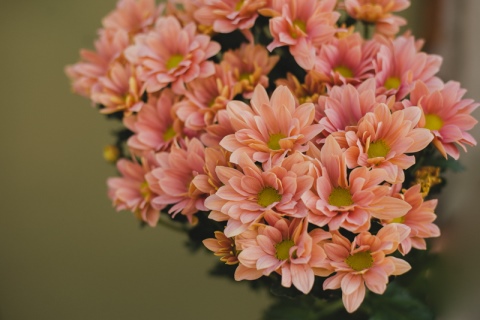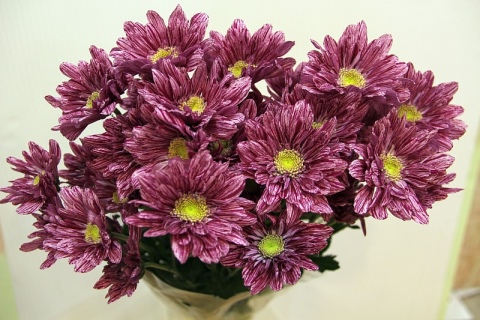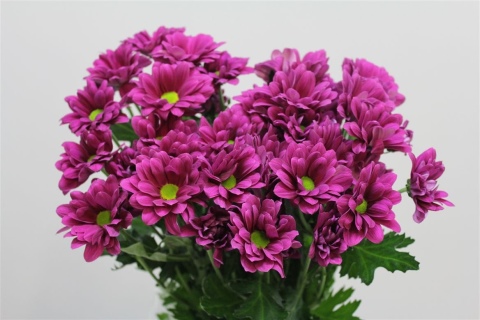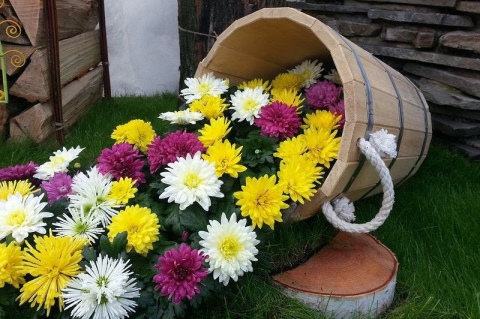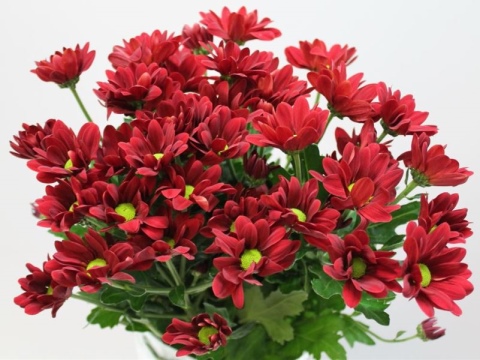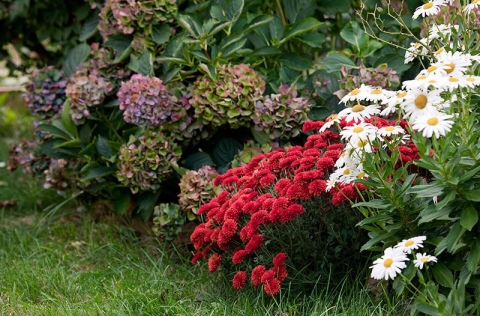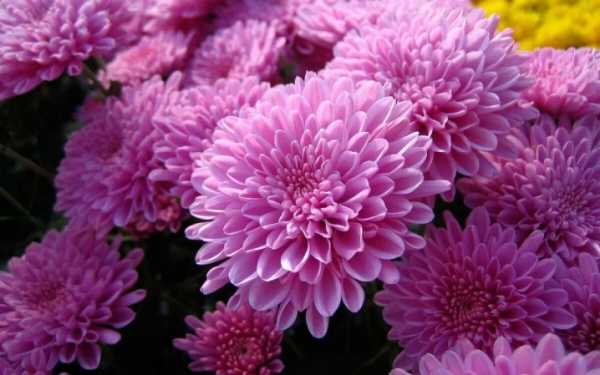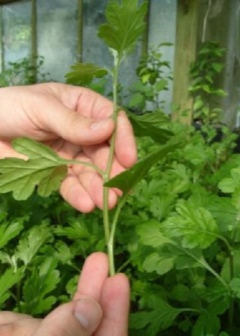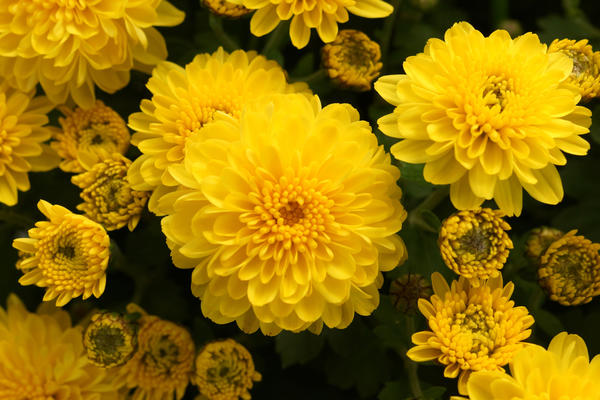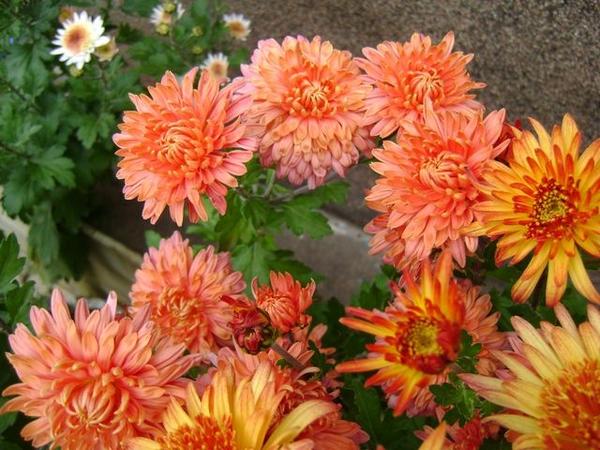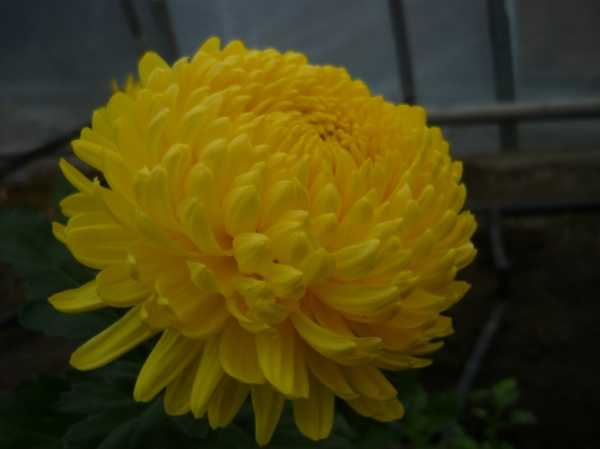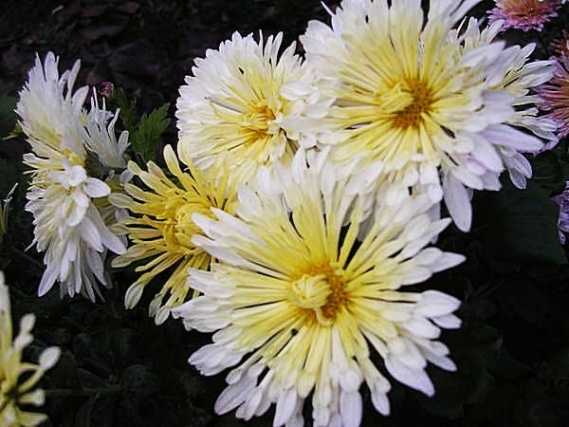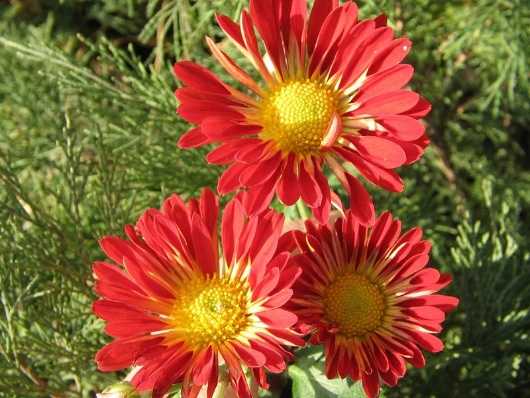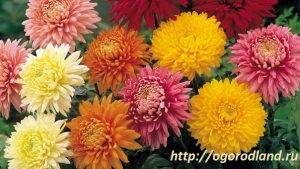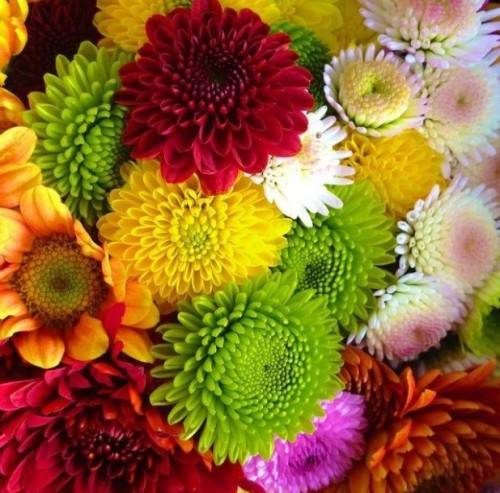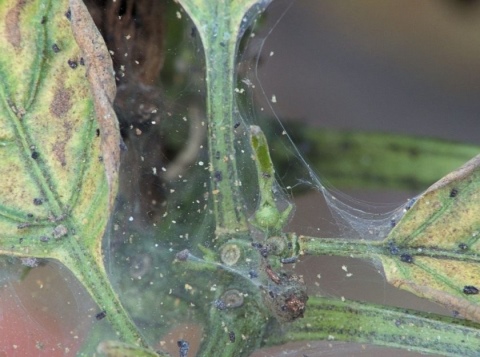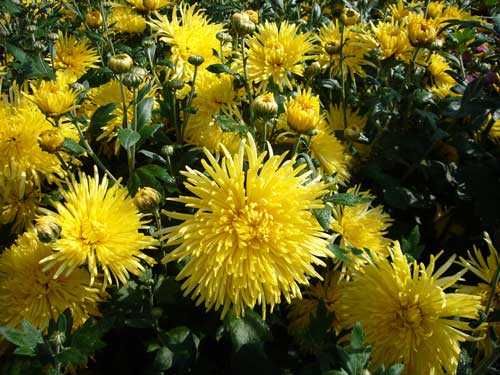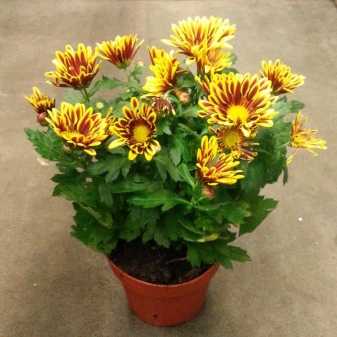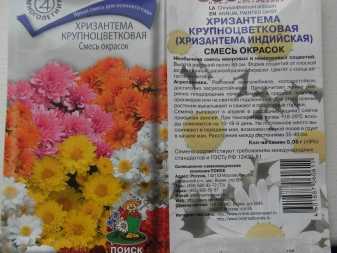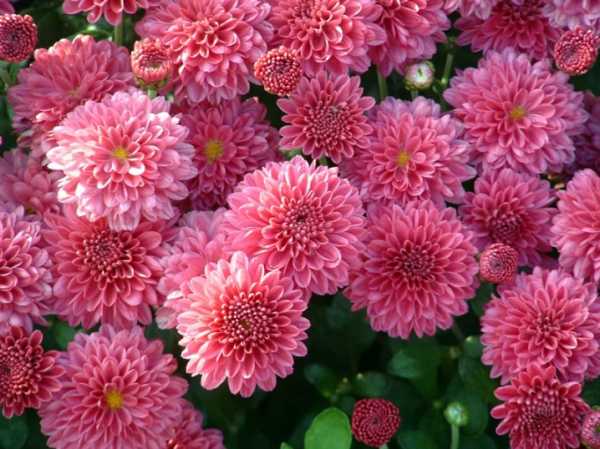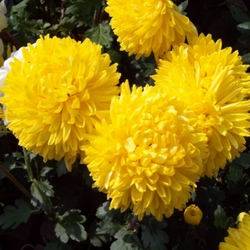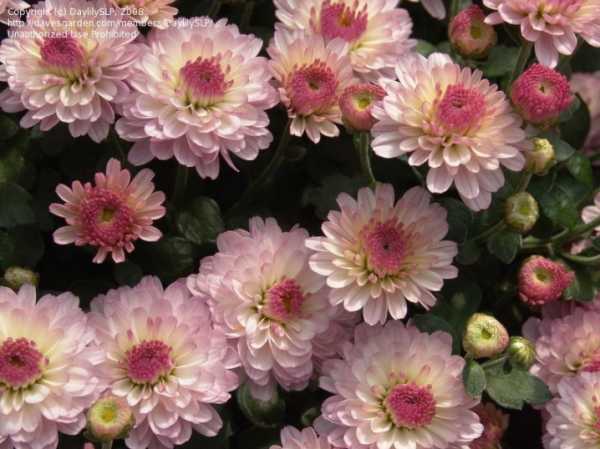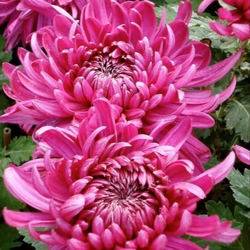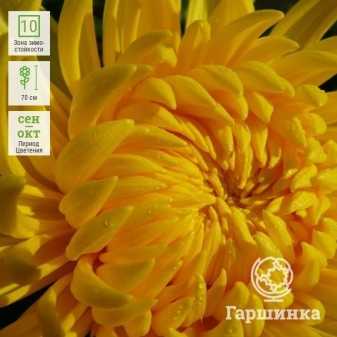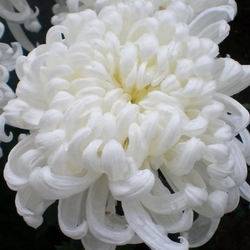Names and descriptions of perennial garden chrysanthemums wintering outdoors
Breeders all over the world have contributed to the creation of the mold variety of chrysanthemums. Each country has its own requirements for the range of these plants. The Japanese prefer spider or ray-shaped inflorescences, the Germans and the British prefer globular varieties, and the Americans prefer anemone flowers. In central Russia, various species overwintering in the open field are widespread.
| Views | Bloom |
|---|---|
| Stallion, Stallion | Yellow, white, pink or creamy small anemone buds. |
| Limoncello, Limoncello | Mini-chrysanthemums with yellow balls of small flowers. The petals completely hide the middle disc. |
| Bontempi, Bontempi | Burgundy large petals of a simple inflorescence frame a greenish center. |
| Stellini, Stellini | Lilac semi-double flowers with a yellow disc of the basket. |
| Keeled, Carinatum | Chamomile simple flowers. The color is variegated. |
| Haydar, Haydar | The petals are purple with a yellow edge, the disc is yellow-green. |
| Crowned, Coronarium | A vegetable variety rich in vitamins. The inflorescences are simple, white or yellow. |
| Crown, Corona | Semi-double basket, yellow with a green center, which can be either visible or hidden. |
| Pina Colada, Pina Colada | Simple or semi-double inflorescence of white, yellow or pink color. |
| Chinese | Low-growing spherical bushes. |
| Marsh, Paludosum | Chamomile-like baskets with yellow center and white petals. |
| Exopolis, Exopolis | Purple, medium-sized. The inflorescence is semi-double. |
| Serenity, Serenity | Simple baskets are purple-white, striped. |
| Rainbow | Colored Dutch hybrids: white, blue, yellow, green. The inflorescence is simple. |
| Deco, Deco | Large-flowered double chrysanthemum: large single flowers. |
| Vip, Vip | Lilac thyroid basket, which becomes darker closer to the center. |
| Grand Salmon, Grand Salmon | Pastel and creamy red simple baskets. |
| Gaidar, Haidar | Lilac or reddish petals of a non-double inflorescence with a wide light border. |
| Raisa | Orange simple baskets with yellow edging of petals. |
| Furor, Furor | Yellow-green or white-green flat inflorescence. |
| Aviator, Aviator | White or pastel hemispherical baskets. |
| Memphis, Memphis | Simple flowers in all shades of purple. |
| Lollipop, Lollipop | Pompous large inflorescences of lilac shades. |
| Snow White | Ball-shaped baskets of white color. |
| Ibis, Ibis | Inflorescences are pompous. The color is white, turning to the center in green. |
| Stripy | Simple baskets are light purple or pink-red with white edging. |
| Skye, Skye | White flowers with a green center-pom-poms. |
| Grand Orange, Grand Orange | Non-double baskets of brick-orange shade. |
It will also be interesting: When to transplant lilies - after flowering, to another place, in autumn or spring
Care in the garden from the moment of planting in the open ground until autumn
Shrub chrysanthemum is unpretentious, but only proper care allows this ornamental plant to maintain its healthy appearance and long flowering. The main, standard measures that should be provided to a chrysanthemum include watering, feeding and pruning.
How to care during growth and flowering: watering, fertilizing, pruning
Chrysanthemums are light-loving ornamental plants with short daylight hours, but for abundant flowering, you need to provide diffused lighting. When grown in indoor floriculture conditions, a flowerpot or pot with a plant is installed on the windowsill of the east or west window. Air humidity is also provided at the level of 40-50%.
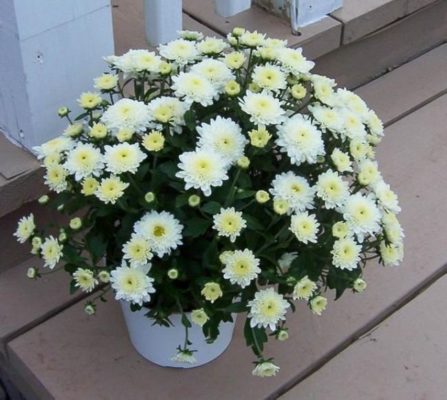
Home-grown chrysanthemums are not demanding to care for, grow well, bloom profusely and multiply easily
Spraying of the aboveground part is carried out mainly in the summer. Despite the fact that chrysanthemums are drought tolerant, irrigation activities are carried out regularly, but not too abundantly.The soil is moistened after the topsoil has dried. For irrigation, it is recommended to use water heated in the sun and settled water.
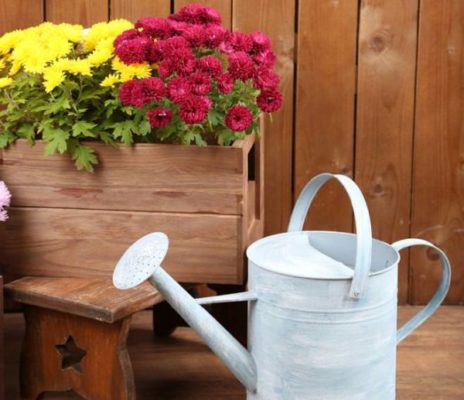
If you plant chrysanthemums of different varieties, suitable for the color of the inflorescences, in one pot, then during the flowering period they will look very impressive
Chrysanthemums respond well to timely feeding, and for abundant flowering, such a plant should be provided with a soil rich in humus and minerals. For the first feeding after planting in a permanent place, organic matter is used with the addition of superphosphate. The second feeding is carried out a couple of weeks after the growing season. The third dressing is applied at the stage of bud formation and should contain 45 g of potassium and 25 g of phosphorus.
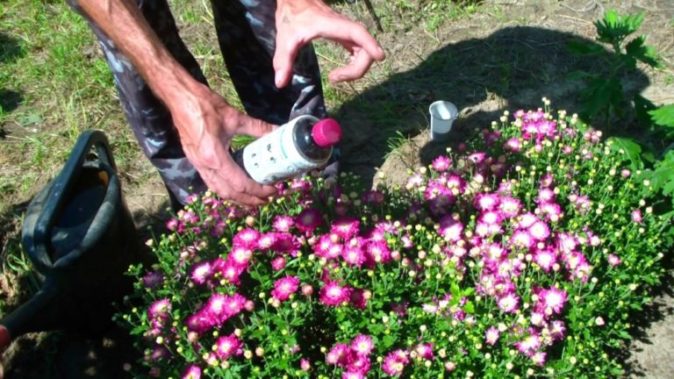
Top dressing should begin 10 days after germination
Pinching and pruning stimulate the formation of new lateral branches on the bush chrysanthemum, and also have a positive effect on the development of the root system. Small-flowered varieties can be pinched over the fifth leaf, which will allow you to get a lush crown. To form large and beautiful inflorescences, all lateral shoots are cut off, as well as all buds, except for the main one.
Leaving after flowering. How to prepare a plant for winter
The preparation of bush chrysanthemums for successful wintering in most regions should be started at the end of August or in September. In open ground conditions in the southern regions, preparation for winter involves the application of phosphorus-potassium fertilizers, pruning after flowering at a height of 10-15 cm above the ground level, hilling and mulching with dry foliage. Spruce branches or dry straw can be used as mulch.
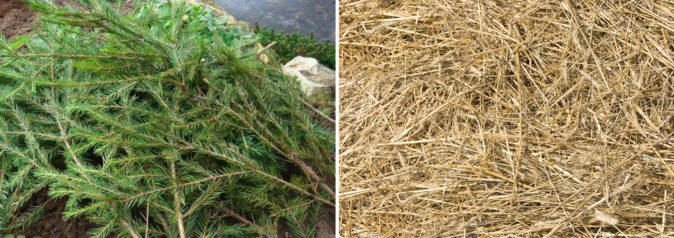
Mulching - covering the soil with mulch to protect it and improve its properties, the role of mulch can be played by a wide variety of materials, for example: straw, spruce branches, bark, sand
Insufficiently winter-hardy large-flowered varieties and European hybrids are dug out together with an earthen clod to preserve in the cold season, after which they are placed in wooden boxes, which are installed in a bright room at a temperature of 2-6 ° C and air humidity within 75-85%. The earthen lump should be periodically moistened. Also, a good result is given by storing chrysanthemums in a basement or cellar.

If you have a choice of where to store chrysanthemums in winter, give preference to a bright room. There is an opinion that without light, during the cold period, the chrysanthemum is depleted, it becomes pale and powerless.
Indoor plants after flowering should also be properly prepared for winter. Dried buds are removed, and all dry and damaged branches and leaves are cut off. The frequency of irrigation measures is gradually reduced, after which the plant pot is installed in a cool place, but without excessive moisture and drafts. During such a period, the indoor ornamental culture is rarely watered, it is kept without fertilizers at an air temperature of 5 ° C. In the spring, the overwintered plant is transplanted. Before flowering, it is better to use nitrogen fertilizers for feeding, and at the time of flowering, nitrate compositions are used.
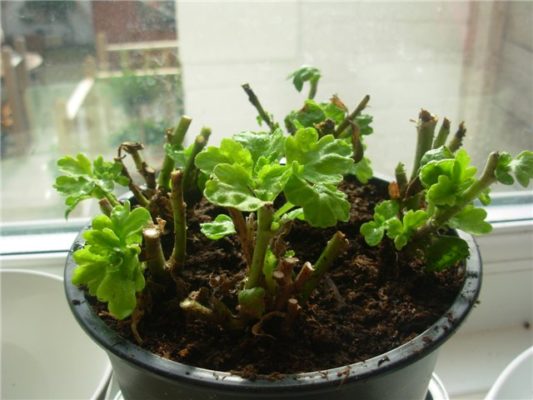
If limited only to spring pruning, the plant will become too elongated and look unattractive.
Growing
The cultivation of Indian chrysanthemum is not difficult, most often it comes from seeds.
It can also be grown from a cuttings, but from seeds it is easier and more reliable.
If you already have a chrysanthemum, then you can propagate it by dividing it every 2-3 years. The likelihood that seedlings grown from seeds will take root is higher than the probability that the cutting will take root.
Growing from seeds
Growing from seeds will have several stages:
- soil preparation;
- seed preparation;
- planting seeds;
- seedling care;
- landing in the ground.
Since the seedlings before the warmth, when the time comes to plant them in the ground, should grow and get stronger, it is necessary to correctly calculate the time of planting the seeds.This requires 2-3 months, depending on the care and conditions: it means that we plant seeds for seedlings in February.
Next, let's talk in more detail, step by step, how to grow a chrysanthemum from seeds.
For planting seeds, you will need boxes with suitable soil. It should be a mixture of peat and sand in a 1: 1 ratio. The soil must be moistened.
Seeds for planting must also be prepared. To do this, they need to be stratified: place the seeds in a damp cloth and a plastic bag, then put them in the refrigerator for 3-4 days or in a room with a temperature of about 4-5 ° C, leave them moist before planting, do not dry them. Seeds must be planted in rows. A sufficient distance is 10 cm between them. The seeds are scattered over the moistened soil, slightly pressed into the soil, slapped - do not sprinkle the earth on top. In addition to moisture, seeds need light.
The boxes are covered with foil. Opened in order to moisten the soil and ventilate. The soil should be constantly moist, but not wet. Seedlings may die from freezing.
When the seeds have sprouted, the soil must be loosened periodically. The film is removed when the seedlings have two or three leaves. The seedlings are planted in the ground when the air and the earth warm up well enough: after the frosts on the soil leave.
Important! Be prepared for the fact that a chrysanthemum grown from seeds will bloom only in the second year. By planting seedlings, the process of growing chrysanthemums from seeds ends
Because the further care of the plant is the same, regardless of how it was grown: from seeds or cuttings
By planting seedlings, the process of growing chrysanthemums from seeds ends. Because further care for the plant is the same, regardless of how it was grown: from seeds or cuttings.
Growing by cuttings
Growing a plant with cuttings can be done in two ways:
- with germination of the cuttings in a pot and planting the finished plant in the ground;
- by germinating the cuttings directly in the open field.
If you chose the first method, then you need to prepare pots with a peat-sand mixture, moisten them and plant cuttings - their length is 15-20 cm. 2/3 should go underground, and 1/3 should remain above the ground.
The soil must be well moistened, but not poured. Since the temperature is suitable in room conditions, you can cover with foil if you wish.
If the room temperature is high, the plant can "suffocate" from the humidity and temperature under the film. Be careful, observe in what conditions the plant is more comfortable. If you covered with a film, then with the appearance of leaves, there is no need for it. Give the plant more light, but not open sun. For pots, an east window is best. Then you just need to wait for the heat to plant the sprouts in open ground.
You can root cuttings even in autumn, even in winter.
When growing chrysanthemums in the second way, cuttings are planted directly in the ground in the spring. They should be about 20-25 cm long so that both the underground and above-ground parts can germinate.
Planting should be done at a distance of 45-50 cm, so that when the bush grows, it will be spacious.
After planting the cuttings, wire arcs must be placed over them and covered with foil. Only the ends of the "greenhouse" can be opened slightly for airing, it is not necessary to open all of it. In no case should the film touch the cuttings, and then - the sprouted buds. The soil needs to be moistened regularly.
When the sprouts have grown stronger, the film is removed, you can feed them with nitrogen fertilizers.
Perennial and annual chrysanthemums: varieties and their photos
Perennial chrysanthemums include all types described in this catalog, with the exception of those that are annual. These plants are distinguished by their ability to give excellent flowering for 3 or more years without transplanting and rejuvenating the bush.
They are usually used to decorate flower beds and flower beds in the landscape design of a personal plot, in park areas.
Among the currently selected and widely used species of annual chrysanthemums, there are several varieties that are distinguished by resistance to adverse environmental conditions.
Next, you can see annual and perennial varieties of chrysanthemums in the photo and evaluate their attractiveness for growing:
Tricolor chrysanthemum.
This plant variety reaches a length of sixty centimeters.
The leaves are thick, gray-green in color.
The diameter of the inflorescence is four to six centimeters.
Varieties:
- "Flammenstahl" This flower has a yellow-brown heart and red petals.
- "Nordstern" This is a fairly large flower of snow-white color with a yellow-red center.
- "Cockard" This variety is a snow-white flower with a carmine base. Blooms in June-September.
Sowing (field) chrysanthemum.
The sown chrysanthemum grows in length up to thirty to sixty centimeters.
The leaves are pinnate below, and serrated above.
Flowers are associated with large daisies. They have light or dark flat middle, their color is snow-white, gray-yellow or pure yellow. The diameter of the flowers is three to five centimeters.
Crowned (crowned) chrysanthemum.
Crown chrysanthemum in height reaches forty centimeters to one meter.
The leaves are pinnate, somewhere pointed.
The flowers are three centimeters in diameter. The lingual form of the flowers has a yellow or white tint, and the tubular flowers have a greenish-yellow tint.
Formation of a beautiful shrub from Korean winter-hardy chrysanthemums
In order for the bushes to grow beautiful, of the correct configuration and bloom profusely, it is necessary to pinch the tops of the center buds and from the side of the growing shoots. In large-flowered varieties, pinching of the main stem is carried out with the formation of 8-9 leaves. This procedure stimulates lateral branching. Then the most developed ones are selected, which are left. The rest of the composition is superfluous, it is removed.
Chrysanthemums with compact buds are pinched from above when 4-5 leaves appear on the shoots. Lateral branches with 8-9 leaves that have subsequently grown are also subjected to a similar procedure. As a result of such simple manipulations, a voluminous bush is obtained.
Wintering chrysanthemums in the open field
Only frost-resistant varieties of perennial garden chrysanthemums are capable of withstanding the winter outdoors. Basically, these are Korean hybrids, perfectly adapted to the climate of central Russia, including they grow in the Moscow region. Thanks to the work of breeders, it has even become possible to grow chrysanthemums in the open field in Siberia. But here, too, there are some nuances. On a dry, elevated area, the plants will not freeze, but if the area is located in a lowland where moisture constantly accumulates, chrysanthemums will freeze.
But even if the correct place for chrysanthemums in the country was chosen (elevated and dry), they will need to be prepared for winter. With the onset of autumn frosts, when the foliage on the bushes withers, the specimens remaining on the street are cut off and preventive treatment with pesticides is carried out (copper oxychloride 0.8% and nitrophene 1%). How to prune bushes? Pruning can be done high and low, to the very root. In the first case, in the spring you will have to remove the remnants of old shoots.
Leaving plants in the ground, they need to be insulated, but not every material is suitable for this purpose. You cannot use as insulation:
- leaves - the ground under them becomes damp and the plants mate;
- sawdust - pathogenic microorganisms develop in them;
- peat - due to the increased moisture capacity, it freezes, and with the onset of spring it thaws for a long time.
In order for the chrysanthemums to winter safely, it is best to do the following: spud the stems with ordinary earth, then cover with boxes, and throw covering material on top in 1-2 layers.It can be purchased in a store or used fabrics, old clothes. Another reliable way to preserve chrysanthemums is to cover the previously hilled bushes with spruce branches or branches (you can cut any), and from above with fallen leaves, with the arrival of the first frost. In order for the chrysanthemums not to rival the shelter, it should not be heavy and dense.
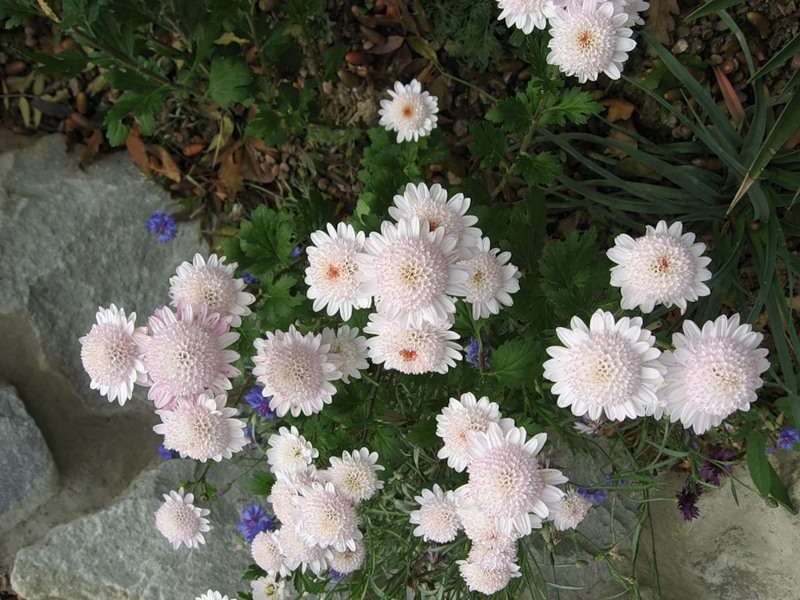 Chrysanthemum white pompon in the garden
Chrysanthemum white pompon in the garden
With the onset of spring, all stems remaining from last year are removed, and the main dead shoot is twisted out of the soil, since its growth does not resume, and the development of the plant occurs due to lateral underground shoots.
In heat-loving non-frost-resistant varieties, the stems are cut off in October, leaving a length of 15–20 cm, and the leaves are cut off. Then the bushes are dug up together with an earthen lump, placed in boxes and transferred to a room with an air temperature of 4–6 ° C, preferably light. When new shoots appear on the bushes, they begin to be watered moderately.
Early varieties of chrysanthemums with names and photos for growing in the garden
When spring comes, we rejoice at the first emerald greenery and a simple bud of primroses, which must be planted in your garden. But I really want a riot of colors and exquisite charm of a mixture of spicy aromas.
Early varieties of chrysanthemums for growing in the garden in a seedling way help to get all this. It is recommended to plant them on seedlings as early as possible, as soon as daylight hours begin to reach 9 hours. This is usually the beginning - mid-February. With such a sowing time, flowering bushes can be obtained in the second half of May.
It is worth noting that it is impossible to plant directly into open ground. It is necessary to harden for 10 - 15 days
Well, by the time of disembarkation, the spring return frosts should have completely passed.
The following are the most popular new early varieties of chrysanthemums with names and photos:
"Zembla yellow"
The flowers are yellow, large in size, spherical in shape, their diameter is fifteen centimeters.
It blooms in September, and with the seedling method of cultivation, the flowering time is shifted to the beginning of June.
"Handsom"
This plant looks like a chamomile. It has a lilac color with a white border.
The flower starts up in September, with the seedling method of growing, the first buds are tied at the end of May ..
"Stern des Orients"
The peculiarity of this variety of chrysanthemum is its light yellow petals and dark core. Flowering begins in mid-June and lasts until the first frost in the fall.
Reproduction, planting, transplanting chrysanthemums
Planting is recommended in the spring. This is necessary for good rooting for the winter. If the flowers were bought in the autumn in a blooming state, then they should not be transplanted into the ground. It is better to leave them to winter in a pot, placing them in the basement or placing them in a hole.
To maintain the decorative effect of the bush, it must be divided every 2 years. If this is not done, the plant quickly grows old and dies. In addition, separated bushes are easier to tolerate winter and autumn cold. Flowers can be easily transplanted, they quickly take root due to the regenerative ability of the rhizome. They can be divided and replanted at any stage of development, even when they are in bloom, as long as the soil is sufficiently moist.
You can propagate chrysanthemums in the following ways:
- seeds;
- cuttings;
- dividing the bush.
In practice, the method of dividing an overgrown adult plant is most often used. This procedure is carried out in early spring. To do this, the bush is dug out and the lateral young shoots with roots are separated from it with a sharp shovel. The middle of the bush is aging quickly, so it makes no sense to plant it. The separated parts are planted in the ground, fertilized with fertilizers containing phosphorus and sprinkled with soil for hilling.

The root system, as it grows, releases many new young shoots, forming a lush bush.
Chrysanthemums are easily propagated by cuttings. You can root a lateral shoot by planting it in the ground.Propagation by cuttings is also better in spring, because at this time the plant is in a period of active growth, and it easily grows young leaves and new roots within two months. A soil consisting of a mixture of sand and earth is well suited for rooting. After the formation of leaves, the tops must be pinched. This will cause the stem to branch out and the bush will be more voluminous.
To obtain seeds, you need to bring the pollinated mother plants to the greenhouse before freezing or cut off the branches with pollinated inflorescences and put them in water. This is how the seeds ripen. After sowing, seedlings appear in a week. Germination capacity is maintained for the next year.
It will also be interesting: Streptocarpus - the names of flowers and descriptions of natural and breeding varieties?
Signs
In China, chrysanthemums are considered not only ornamental plants, but also spices. They also attribute magical properties to this flower that can prolong life. In Vietnam, he personifies purity of soul and clarity of mind.
The Japanese are sure that chrysanthemums bring good luck to their owner. In the 8th century, this plant was allowed to grow only in the emperor's garden. His image could only adorn the clothes of members of the imperial family. A mere mortal who painted a chrysanthemum was put to death. The Japanese name for the flower is translated as "sun". According to legend, the Japanese people descended from the rising sun, so this representative of the Astrovs became the national symbol of this country.

Today there is a traditional Japanese festival called Chrysanthemum Day, organized for the first time in the 10th century by Emperor Uda, who allowed an exhibition of these flowers.
The spherical white or pink variety is considered a symbol of tenderness and love. Such flowers can be presented to your wife or girlfriend. Dark red elegant shades are suitable for a bouquet for a woman of age. But for men it is better to present a bouquet, the shades of which symbolize wealth, influence and nobility: yellow, purple or orange.

It will also be interesting: Deciduous azalea (garden, marsh, street) - planting and care?

